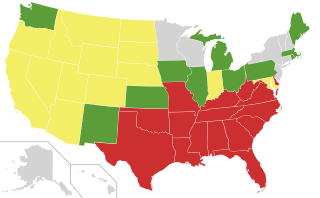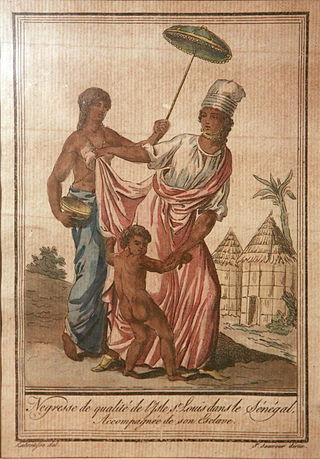Related Research Articles

The Atlantic slave trade or transatlantic slave trade involved the transportation by slave traders of enslaved African people, mainly to the Americas. The outfitted European slave ships of the slave trade regularly used the triangular trade route and its Middle Passage, and existed from the 16th to the 19th centuries. The vast majority of those who were transported in the transatlantic slave trade were people from Central and West Africa who had been sold by West African slave traders to mainly Portuguese, British, Spanish, Dutch, and French slave traders. while others had been captured directly by the slave traders in coastal raids; European slave traders gathered and imprisoned the enslaved at forts on the African coast and then brought them to the Americas. Except for the Portuguese, European slave traders generally did not participate in the raids because life expectancy for Europeans in sub-Saharan Africa was less than one year during the period of the slave trade.
Miscegenation is sexual relations or marriage between people who are considered to be members of different races. The word, now usually considered pejorative, is derived from a combination of the Latin terms miscere and genus ("race"). The word first appeared in Miscegenation: The Theory of the Blending of the Races, Applied to the American White Man and Negro, a hoax anti-abolitionist pamphlet David Goodman Croly and others published anonymously in advance of the 1864 presidential election in the United States. The term came to be associated with laws that banned interracial marriage and sex, which were known as anti-miscegenation laws.

The slave codes were laws relating to slavery and enslaved people, specifically regarding the Atlantic slave trade and chattel slavery in the Americas.

The Barbados Slave Code of 1661, officially titled as An Act for the better ordering and governing of Negroes, was a law passed by the Parliament of Barbados to provide a legal basis for slavery in the English colony of Barbados. It is the first comprehensive Slave Act, and the code's preamble, which stated that the law's purpose was to "protect them [slaves] as we do men's other goods and Chattels", established that black slaves would be treated as chattel property in the island's court.

The Blockade of Africa began in 1808 after the United Kingdom outlawed the Atlantic slave trade, making it illegal for British ships to transport slaves. The Royal Navy immediately established a presence off Africa to enforce the ban, called the West Africa Squadron. Although the ban initially applied only to British ships, Britain negotiated treaties with other countries to give the Royal Navy the right to intercept and search their ships for slaves.

British West Africa was the collective name for British colonies in West Africa during the colonial period, either in the general geographical sense or the formal colonial administrative entity. British West Africa as a colonial entity was originally officially known as Colony of Sierra Leone and its Dependencies, then British West African Territories and finally British West African Settlements.
Anna Madgigine Jai Kingsley, born Anta Madjiguène Ndiaye, also known as Anta Majigeen Njaay or Anna Madgigine Jai, was a West African from present-day Senegal, who was enslaved and sold in Cuba, probably via the slave pens on Gorée Island. In Cuba she was purchased, as wife, by plantation owner and slave trader Zephaniah Kingsley. After his death, she became a planter and slave owner in her own right, as a free Black woman in early 19th-century Florida.

Interracial marriage is a marriage involving spouses who belong to different races or racialized ethnicities.

The Dutch Gold Coast or Dutch Guinea, officially Dutch possessions on the Coast of Guinea was a portion of contemporary Ghana that was gradually colonized by the Dutch, beginning in 1612. The Dutch began trading in the area around 1598, joining the Portuguese which had a trading post there since the late 1400s. Eventually, the Dutch Gold Coast became the most important Dutch colony in West Africa after Fort Elmina was captured from the Portuguese in 1637, but fell into disarray after the abolition of the slave trade in the early 19th century. On 6 April 1872, the Dutch Gold Coast was, in accordance with the Anglo-Dutch Treaties of 1870–71, ceded to the United Kingdom.

The Portuguese Gold Coast was a Portuguese colony on the West African Gold Coast along the Gulf of Guinea. Established in 1482, the colony was officially incorporated into Dutch territory in 1642 following Portugal’s defeat in the Dutch-Portuguese War. From their seat of power at the fortress of São Jorge da Mina, the Portuguese commanded a vast internal slave trade, creating a slave network that would expand after the end of Portuguese colonialism in the region. The primary export of the colony was gold, which was obtained through barter with the local population. Portuguese presence along the Gold Coast increased seamanship and trade in the Gulf, introduced American crops into the African agricultural landscape, and made Portuguese an enduring language of trade in the area.

Slave raiding is a military raid for the purpose of capturing people and bringing them from the raid area to serve as slaves. Once seen as a normal part of warfare, it is nowadays widely considered a crime. Slave raiding has occurred since antiquity. Some of the earliest surviving written records of slave raiding come from Sumer. Kidnapping and prisoners of war was the most common source of African slaves, although indentured servitude or punishment also resulted in slavery.

Kingsley Plantation is the site of a former estate on Fort George Island, in Duval County, Florida, that was named for its developer and most famous owner, Zephaniah Kingsley, who spent 25 years there. It is located at the northern tip of Fort George Island at Fort George Inlet, and is part of the Timucuan Ecological and Historic Preserve managed by the U.S. National Park Service. Kingsley's house is the oldest plantation house still standing in Florida, and the solidly-built village of slave cabins is one of the best preserved in the United States. It is also "the oldest surviving antebellum Spanish Colonial plantation in the United States."
Zephaniah Kingsley Jr. was a plantation owner, born in England, who moved as a child with his family to South Carolina, and became a planter, slave trader, and merchant. He built four plantations in the Spanish colony of Florida near what is now Jacksonville, Florida. He served on the Florida Territorial Council after Florida was acquired by the United States in 1821. Kingsley Plantation, which he owned and where he lived for 25 years, has been preserved as part of the Timucuan Ecological and Historic Preserve, run by the United States National Park Service. Finding his large and complicated family progressively more insecure in Florida, he moved them to a vanished plantation, Mayorasgo de Koka, in what was then Haiti but soon became part of the Dominican Republic.

Interracial marriage has been legal throughout the United States since at least the 1967 U.S. Supreme Court decision Loving v. Virginia (1967) that held that anti-miscegenation laws were unconstitutional via the 14th Amendment adopted in 1868. Chief Justice Earl Warren wrote in the court opinion that "the freedom to marry, or not marry, a person of another race resides with the individual, and cannot be infringed by the State." Interracial marriages have been formally protected by federal statute through the Respect for Marriage Act since 2022.

African Slave Trade Patrol was part of the Blockade of Africa suppressing the Atlantic slave trade between 1819 and the beginning of the American Civil War in 1861. Due to the abolitionist movement in the United States, a squadron of U.S. Navy warships and Cutters were assigned to catch slave traders in and around Africa. In 42 years about 100 suspected slave ships were captured.

Panyarring was the practice of seizing and holding persons until the repayment of debt or resolution of a dispute which became a common activity along the Atlantic coast of Africa in the 18th and 19th centuries. The practice developed from pawnship, a common practice in West Africa where members of a family borrowing money would be pledged as collateral to the family providing credit until the repayment of the debt. Panyarring though is different from this practice as it involves the forced seizure of persons when a debt was not repaid.

Signares were black and mulatto Senegalease women who have an influence via their marriage with European men and their patrimony. These women of color managed to gain some individual assets, status, and power in the hierarchies of the Atlantic Slave Trade.
Henry Hawley was the English Governor of Barbados from 1630 to 1639/40.
Gold Coast Euro-Africans were a historical demographic based in coastal urban settlements in colonial Ghana, that arose from unions between European men and African women from the late 15th century – the decade between 1471 and 1482, until the mid-20th century, circa 1957, when Ghana attained its independence. In this period, different geographic areas of the Gold Coast were politically controlled at various times by the Portuguese, Germans, Swedes, Danes, Dutch and the British. There are also records of merchants of other European nationalities such as the Spaniards, French, Italians and Irish, operating along the coast, in addition to American sailors and traders from New York, Massachusetts and Rhode Island. Euro-Africans were influential in intellectual, technocratic, artisanal, commercial and public life in general, actively participating in multiple fields of scholarly and civic importance. Scholars have referred to this Euro-African population of the Gold Coast as "mulattos", "mulatofoi" and "owulai" among other descriptions. The term, owula conveys contemporary notions of "gentlemanliness, learning and urbanity" or "a salaried big man" in the Ga language. The cross-cultural interactions between Europeans and Africans were mercantile-driven and an avenue to boost social capital for economic and political gain i.e. "wealth and power." The growth and development of Christianity during the colonial period also instituted motifs of modernity vis-à-vis Euro-African identity. This model created a spectrum of practices, ranging from a full celebration of native African customs to a total embrace and acculturation of European culture.
Hans Werner Debrunner was a Swiss German historian and theologian whose work mainly covered mission history, West Africa and the African diaspora. He also carried out academic research on history relating to missiology in northern, eastern and southern Africa. Upon his death in 1998, his private library and archive were donated to the Carl Schlettwein Foundation. The "independent, self-contained collection" comprises more than 3100 books and single journal issues on his area of specialty, published mostly in the first half to mid-twentieth century. Furthermore, Debrunner’s academic archives are a compilation of historiography and ethnography, particularly bio-bibliographies of Swiss missionaries and native African pastors and missionaries who worked with the Basel Mission in Africa. Debrunner also documented history, socio-political and intercultural relations between Africa and Europe. Hans Debrunner’s accounts explored the life and works of African saints, royalty, aristocrats, noblemen, political envoys, writers, intellectuals, scholars and artists who lived in or visited Europe from the early medieval period through the Enlightenment until the end of the World War I era.
References
- ↑ Pernille Ipsen (2013). ""The Christened Mulatresses": Euro-African Families in a Slave-Trading Town". The William and Mary Quarterly. 70 (2): 371–398. doi:10.5309/willmaryquar.70.2.0371. JSTOR 10.5309/willmaryquar.70.2.0371.
- ↑ Kea, Ray A. (2016). "Daughters of the Trade: Atlantic Slavers and Interracial Marriage on the Gold Coast, written by Pernille Ipsen". New West Indian Guide. 90 (3–4): 317–318. doi: 10.1163/22134360-09003015 . ProQuest 1854223329.
- ↑ "Ghana - Arrival of the Europeans". countrystudies.us. Archived from the original on 2016-11-03. Retrieved 2018-12-22.
- ↑ Ipsen, Pernille (2015). Daughters of the Trade: Atlantic Slavers and Interracial Marriage on the Gold Coast. University of Pennsylvania Press. pp. 1, 21, 31. ISBN 978-0-8122-4673-5.
- ↑ Ipsen, Pernille (2015). Daughters of the Trade: Atlantic Slavers and Interracial Marriage on the Gold Coast. ISBN 978-0-8122-4673-5.[ page needed ]
- ↑ Ray, Carina E. (1 February 2014). "Decrying White Peril: Interracial Sex and the Rise of Anticolonial Nationalism in the Gold Coast". The American Historical Review. 119 (1): 78–110. doi: 10.1093/ahr/119.1.78 .
- ↑ Hardwick, Julie; Pearsall, Sarah M. S.; Wulf, Karin (2013). "Introduction: Centering Families in Atlantic Histories". The William and Mary Quarterly. 70 (2): 205–224. doi:10.5309/willmaryquar.70.2.0205. JSTOR 10.5309/willmaryquar.70.2.0205.
- ↑ Ray, Carina E. Crossing the Color Line: Race, Sex, and the Contested Politics of Colonialism in Ghana. Ohio University Press.[ page needed ][ date missing ][ ISBN missing ]